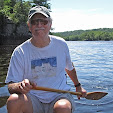Kenya safari.)
Heading southwest from Lake Naivasha, we drove for about five hours toward the Maasai Mara National Reserve, the last hour-and-a-half on rough, dusty, dangerous roads.
Besides Tanzania's immense Serengeti National Park, the Maasai Mara is the African wild game reserve the rest of the world has seen most represented in Nature writing, photography and film. The area comprises some 580 square miles, contiguous with the Serengeti.
Like the movie star you've seen only in pictures, the bigger-than-life reality of the great expanse left us speechless.
The Mara is home to all of wild game's "big five," the animals most sought after, originally by trophy hunters, and now by photographers: lion, leopard, elephant, rhinoceros and cape buffalo. It is also the setting for the awesome annual migration of millions of wildebeest, zebra and other grazing animals to and from the Serengeti.
SEEING RED
This is also Maasai country, where what is arguably the proudest, most colorful and, many say, most authentic of Kenya's 42 tribal peoples still practices its ancient herding lifestyle. Though the Maasai are—or once were—a presence in nearly all the areas we visited in Kenya, it is here that their traditions and lifestyle seemed most evident.
Our home for the next two days was the Siana Springs tent camp, set in a lush oasis originally placed in conservancy by the area's first game warden in the 1920s and bequeathed to the local community in the late 70s.
LIVING ROOM
 After
a brief cultural orientation by our elegant, articulate host, JJ, I set
off on my own to explore one of the compound's winding, wooded paths.
Rounding a corner and ducking under a low doorway of vines, I found
myself in a "room" of dense foliage surrounding a lovely lily pond.
Birds' chatter echoed around the enclosure, sweetening the cool, moist
air.
After
a brief cultural orientation by our elegant, articulate host, JJ, I set
off on my own to explore one of the compound's winding, wooded paths.
Rounding a corner and ducking under a low doorway of vines, I found
myself in a "room" of dense foliage surrounding a lovely lily pond.
Birds' chatter echoed around the enclosure, sweetening the cool, moist
air.(In general, the climate we experienced in Kenya was one of our greatest surprises. Having barely researched the trip, we'd expected very hot weather. Instead, we were met everywhere with the normal conditions for what is, for Kenyans, their mid-winter: cool, dry and beautiful. In the higher elevations of the Aberdare region the temperature had dipped into the 40s at night.)
STRANGE FAMILIARITY
Later, we embarked on our afternoon/evening game drive in the reserve. This was indeed the iconic, sweeping African landscape we've grown up knowing through TV and film. And I wondered if the familiarity might run deeper, in some latent layer of our genes, as this savanna, archeologists say, was the very cradle of human life.
Like the movie star you've seen only in pictures, the bigger-than-life reality of the great expanse of amber grassland, dotted with graceful, umbrella-shaped acacia trees, left us speechless.
In that brief outing, curtailed by nightfall, the Mara just teased us with the sights it held in store for tomorrow's longer game drives: cape buffalo, topi, zebra and, perhaps most impressive, a broad panorama of wildebeest, scattered across the fields' golden undulations as far as the eye could see.
We were to learn more the following day about the hapless wildebeest and its perilous co-existence with the Mara's most fearsome apex predator. (It may not be the one you think.)
(TO BE CONTINUED)












2 comments:
What an amazing, amazing place and what an adventure that must have been! Your photos are gorgeous! I'll enjoy perusing previous posts. :)
PS - Jealous about your flight dreams. I've never had any.
Thanks, Talon -- Sorry I haven't seen your comment (I seldom check this, my second blog). I appreciate your following my blog(s)and hope you're well.
Post a Comment